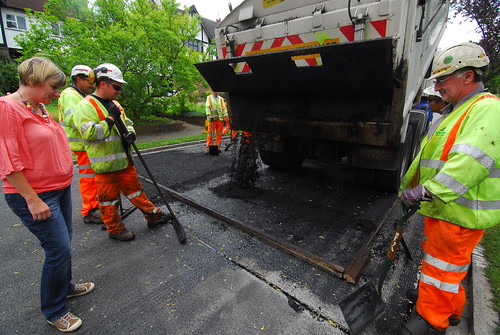
I should admit that I am a bit obsessed with speed humps, especially as a civil engineer how to build speed humps which I see a lot of speed humps which are just built without any projection nor calculation; some too short, some too high and some with so short intervals that I saw three speed humps built side by side which you feel you are on the off road and etc.; But in total making me annoying.
So I tried to gather various sources together and prepare a reference; here is how to build speed humps by specifications and standards;
What is a speed hump (First definition about which kind of speed hump we are talking?)
A speed hump is a raised area of pavement on the roadway surface that extends across the pavement width for reduce the negative effects of motor vehicle use, alter driver behavior, and improve conditions or pedestrians and non-motorized street and roadway users.
Typical Speed Hump Standards
- The typical hump has a design speed of 40kp/h (25mp/h)
- 3.6m to 4m (12 -14 feet) long in the direction of travel.
- Shall design in a range 50 to 100 mm (2 to 4 inches) in height but Most communities limit height to 50 mm (3-3½ inches), partly because of harsh ride over 100mm (4-inch) high humps.
- speed humps shall be installed at least 60 m (200 feet) apart but not greater than 150 to 225 m (500 to 750 feet) apart where the desired 85th percentile operating speed is between 40 and 48 km/h (25 and 30 mp/h). Short road segments may require only a single speed hump even where two could be installed as acceleration opportunities are limited on a short segment

- Speed humps should NOT be installed in the path of a pedestrian crossing or curb ramp.
- Speed humps should NOT be installed over manholes, water valves or adjacent to fire hydrants.
- And for me most important part that all the time they make same mistake; Speed humps should be located near a streetlight to ensure nighttime illumination (at least not deep in the dark),
- Speed humps must be visible from a distance of at least 75m (250 feet) using the AASHTO measurement procedures. Speed humps should not be used on curves unless the radius is greater than 90m (300 feet).
- Speed humps should NOT be installed less than 45m (150 feet) from stop sign or yield sign, and 75m (250 feet) from a traffic signal.
- The Speed Hump sign should be used to give warning of a vertical deflection in the roadway. Adequate signing and marking of each speed hump is essential to warn roadway users of the hump’s presence and guide their subsequent movements. (Please, please, please put a sign for the drivers)
- Speed Humps shall be marked with retro reflective pavement-marking compound (Shapes differs from V shape (most common) to different shapes based on the country and state)

Speed Hump installation Criteria (Where Speeds humps would be installed)
- The street must be classified as a “local” street.
- The street grade must not exceed 8%.
- The posted speed limit must be 48kp/h (30 MP/H) or less.
- The street must NOT be a primary bus route or truck route
- The street must NOT be a primary emergency vehicle route (such as a main approach to a hospital or fire house)

Equation describes the shape of a parabolic hump:
Y = K H x (W – x) / W²
Where H is the highest hump cross-section point, K is the slope coefficient and is within 1- 4, and W is the width of the hump cross-section.
Potential Impacts:
- No effect on non-emergency access.
- Concern over jarring of emergency rescue vehicles so not suggested to build on the hospital/emergency access ways.
- Approximate delay of between 3 and 5 seconds per hump for fire trucks and up to 10 seconds for ambulance with patient so not suggested to build on the hospital/emergency access ways
- Speeds determined by height and spacing; speeds between humps have been observed to be reduced between 20 and 25 percent on average
- Based on a limited sample of site
- Speeds typically increase approximately 0.8km/h (0.5 mp/h) midway between humps for each 90m (100 feet) of separation
- Studies indicate that traffic volumes have been reduced on average by 18 percent depending on alternative routes available
- Studies indicate that collisions have been reduced on average by 13 percent on treated streets (not adjusted for traffic diversion)
- Possible increase in traffic noise from braking and acceleration of vehicles, particularly buses and trucks
More detailed data on: “Analysis and synthesis of speed limiting; Road Humps (Jan Peter Hessling, SP Technical Research Institute of Sweden, Measurement Technology) can be find here.
Typical Cost:
Approximately $2,000 (1997 dollars) as per U.S.
Detailed Information / Resources:
- The District of Columbia Speed Hump Request Procedures and Engineering Guidelines U.S:
http://www.anc5c.biz/sitebuildercontent/sitebuilderfiles/speed_hump_request_procedure.pdf
- Enhanced speed humps construction notes taken from city of Boca Rotan Florida/Us:
Enhanced speed humps construction notes
http://www.ci.boca-raton.fl.us/muni/pdf/traffic/C-443-ENHANCED-SPEED-HUMPPage1-Constr.pdf
- Institute of Transportation Engineers: Updated Guidelines for the Design and Application of Speed Humps (Margaret Parkhill, P.Eng., Rudolph Sooklall, M.A.Sc, Geni Bahar, P.Eng.)
Updated Guidelines for the Design and Application of Speed Humps
- Gwinnett county department of transportation traffic engineering and planning division speed hump program manual Georgia/ U.S.:
- Analysis and synthesis of speed limiting Road Humps (Jan Peter Hessling) SP Technical Research Institute of Sweden, Measurement Technology:
- First photo taken from Flickr, Copyright All rights reserved by yourcroydon; https://www.flickr.com/photos/yourcroydon/5933438990/sizes/m/

Leave a Reply
You must be logged in to post a comment.